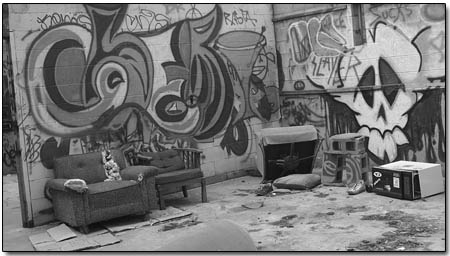 |
| A hollowed out building is
marked with graffiti in downtown Durango. Despite a flourishing
of gang activity in Northern New Mexico, including Farmington
and Aztec, local police say gang-related crime has yet to
make its way north of the border. /Photo by Todd Newcomer. |
Gangs are flourishing just across the Colorado/New
Mexico border. Farmington, Aztec and other areas of Northern
New Mexico have become havens for street gang activity that
is widespread and becoming harder to spot. On the up side, local
law enforcement says the trend crosses the border and into La
Plata County only occasionally and has yet to prompt local concern.
Since Jan. 1, two drive-by shootings have taken place in Farmington,
and officers apprehended four heavily armed individuals roaming
the streets late one evening.
In a likely related incident, a driver of a vehicle lost control
and crashed the same night. Upon investigating the scene, officers
found five pistols, one of which was clutched in a dying man’s
hand, as well as an assault rifle.
A different kind of demographic
The Farmington Police Department Gang Enforcement Unit reports
that there are 15 known gangs in Farmington containing 519 members.
An additional seven gangs call Bloomfield and Aztec home; Kirtland
has two gangs; and eight gangs reportedly roam the Navajo Reservation.
Unlike the notorious Bloods and Crips, Northern New Mexico’s
gangs are frequently mixed race and hard to differentiate. They
have names ranging from Chicano Pride and Southside Locos to
the Latin Kings and the Westside 60s.
With an eye on a situation that is worsening, Farmington Detective
Sgt. Pat Cordell said that the number and intensity of gangs
in Farmington is a good barometer of community health. He noted
that people generally join gangs because they are missing something
on the home front. Once gang members are inside, the gang becomes
appealing for other reasons.
“It’s indicative of a bad family environment where
a child is looking for a sense of belonging,” Cordell
said. “But it quickly can become somewhat lucrative when
they get involved in the criminal activity.”
Judy Pacheco-Sanchez, program director of Albuquerque’s
Gang Intervention Program, concurred. Youth Development Inc.
established the Gang Intervention Program to work with individual
gang members and expose gang them to positive alternatives to
gang-banging.
“Some join for a sense of belonging, and others are intimidated
into it,” Pacheco-Sanchez said.
In Albuquerque, there are 90 documented gangs and an estimated
8,000 gang members. Pacheco-Sanchez said that people also join
gangs for another reason – it’s the family business.
“Others are born into it and following in the footsteps
of their parents and even grandparents,” Pacheco-Sanchez
said, noting that gang members can range in age from 11 to senior
citizens.
In the business
When it comes to street gangs, going into business usually
means trafficking drugs, methamphetamine and crack cocaine in
particular. Cordell commented that dealing and trafficking drugs
creates one set of problems for law enforcement and another
set of related problems involving damage and theft of property.
“Drugs are always going to be a big part of it,”
he said. “From demand for drugs, you get property crimes
including theft and burglary.”
Violence is another direct spin-off of drug trafficking. Cordell
related a situation of two rival gangs, one selling crack and
the other selling meth. He said that the crack-oriented gang
made an entrance into the methamphetamine market, drove the
price down and provoked a hostile response. “The gang
that originally had the meth took steps to control that market,”
he said.
The intensity of violence also has grown, according to Cordell.
It is now common for gang members to be equipped with firearms,
and assault weapons are not uncommon.
 |
| Spray-paint tagging is a common way gang
members mark their territory. However, local law enforcement
says gangs have become more discreet in how they identify
themselves, opting for mainstream colors and signs in an
effort to escape the scrutiny of local police./ Photo by
Todd Newcomer. |
Welcome to New Mexico
Cordell and Pacheco-Sanchez said that one of the reasons Farmington
and New Mexico as a whole have their hands full with gang activity
is that the state is generally more lenient on crime. Both said
that known felons have flooded into New Mexico from urban areas
on both coasts. Specifically, they cited California’s
“Three Strikes and You’re Out” law as a major
gang motivator. The law basically means life in prison for people
convicted of three felonies in California. Cordell noted that
there is nothing in New Mexico even approaching an equivalent
to the law.
“Instead of three strikes and you’re out, we have
the two strikes and you move to New Mexico,” he said.
“We’re sorely in need of some legislation to make
this less of an appealing place for gang members. But remember,
this was also one of the last states to adopt sex-offender registration.”
Pacheco-Sanchez agreed. “We’ve been hearing that
for quite a while about many states and especially California,”
she said. “Gang members can get away with drug trafficking
for a few weeks there or they can come to New Mexico and get
away with it for a couple years.”
However, light legislation is not the only thing enabling gang
members to prosper. As law enforcement has clued into their
habits, gang members have become savvier.
Gang members’ “colors” now tend toward the
mainstream. Gone are the days of Raiders jackets and red bandanas.
Markings are now considerably more subtle.
“Initially when the gangs first started becoming obvious
they were very extroverted about being gang members and wore
specific clothing and had certain tattoos,” Cordell said.
“They realized they were drawing attention from the police
and having trouble doing business.”
Over the border
Whether the gangs of Farmington, Aztec, Kirtland and the Navajo
Reservation have crossed into Colorado and started doing business
in Durango is difficult to discern. If there is a significant
gang presence in Durango, it’s also a discreet one, according
to local law enforcement.
Captain Dale Smith, of the Durango Police Department, said
that with the exception of some isolated incidents, local officers
have not seen gang activity in downtown Durango.
“Some of the gang-bangers come up from the New Mexico
area to Durango, and some probably even live up here,”
Smith said. “But all of the activity is focused down there.”
Kelly Davis, a sergeant with the La Plata County Sheriff’s
Office, agreed, saying, “What we see are incidents that
are few and far between if we can even attribute them to street
gangs.”
However, Davis added that local law enforcement is aware of
the situation in New Mexico and has its guard up. “We
know they’re out there, and we know that occasionally
they have conflicts over whose area of influence this is,”
he said. “Still, it hasn’t manifested itself in
much street-level activity.”
Having had its hands full of street-level activity, the Farmington
Police Department is happy for a break between flare-ups, according
to Cordell.
“We kind of had a flurry of activity around the beginning
of the year, and it has subsided.” he said. “Hopefully,
it will stay that way for a little while.”

